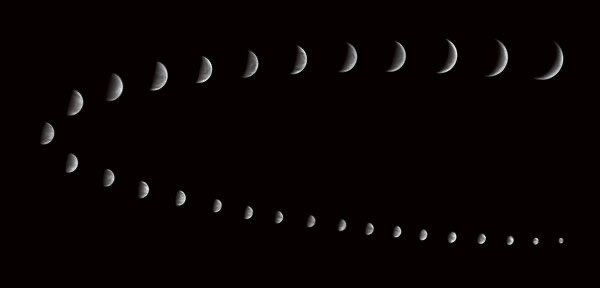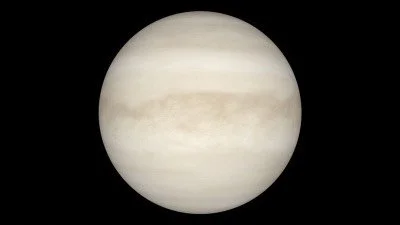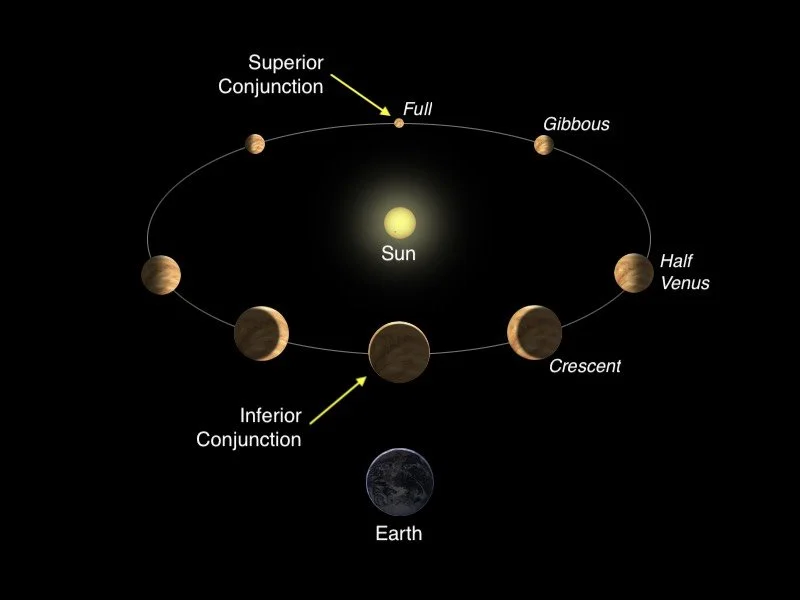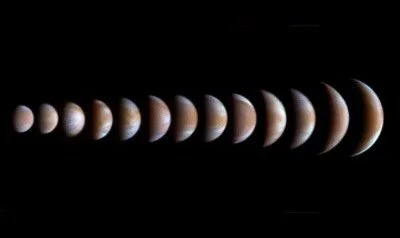Orphic Astrology
Venus Portal
The Phases of Venus
Venus' synodic cycle is approximately 19 months (584 days) which can be divided by four primary phases, each of which lasts 146 days: New Venus, First Quarter Venus, Full Venus, and Last Quarter Venus.
Phases of Venus captured by Sean Walker
Venus' synodic cycle is approximately 19 months (584 days) which can be divided by four primary phases, each of which lasts around 146 days: New Venus, First Quarter Venus, Full Venus, and Last Quarter Venus. These are then subdivided to include the Waxing/Waning Crescent and Gibbous secondary phases.
New Venus phase captured by ESO
The New Venus phase can be seen thru a telescope as a halo of the planet's atmosphere refracting particles of light since it is relatively lower and closest to us between the Earth and the Sun at this time (see image above). Four days following this interior cazimi event (or inferior conjunction) Venus emerges from out past the beams of the Sun to make its first visibility as a waxing crescent morning star on the eastern horizon just before dawn. Then about 5 months (146 days) later Venus will be seen in their first quarter phase, noticeably less luminous.
Crescent to Quarter Venus
The Full Venus phase occurs when Venus makes a superior conjunction to the Sun approximately 9 months (292 days) following the New phase. Though Venus is reflecting light at its fullest, the planet is furthest from us on the opposite side of the Sun and is now invisible for the longest stretch of its transit (usually between 50-80 days). Venus can only be seen through telescopic observations during the superior conjunctions when the planet is behind and above the Sun.
Full Venus captured by NASA
Following the superior conjunction approximately 4 weeks later Venus begins to appear waning gibbous as an evening star on the eastern horizon. After another 146 days Venus continues to wane, reaching greatest elongation at the last quarter phase. Then Venus begins appearing brighter and brighter on the western horizon through the final leg of their journey as a waning crescent evening star before stationing retrograde to begin the cycle anew.
Diagram by earthsky.org
As we approach the inferior conjunction and New phase of Venus, in the weeks prior we see them appear brightest in the evening sky. Despite being at their thinning (waning) crescent phase, Venus is most luminous as an evening star at this time since this is when the planet approaches Earth in their orbit and by proximity looms bigger and brighter in our sky. Approximately two weeks before stationing retrograde the luminosity of evening star Venus also spikes due to their atmosphere reflecting more light at the angle they are to us on Earth. Another spike occurs once Venus is prograde and rising as a morning star reaching that same angle. Morning star Venus usually reaches maximum brightness during the new cycle about two weeks following the direct station.
Gibbous to Crescent Venus phases
The Evening Setting of Venus (their last day of visibility as an evening star) takes place four days prior to the event of the inferior conjunction. At this moment Venus disappears from view for 8 days. Venus begins to rise as a Morning star, making their first visibility 4 days following the inferior conjunction or retrograde cazimi.
Venus retrogrades occur approximately every 18 months and each lasting about 42 days (or 6 weeks). About 3 weeks (21 days) into the retrograde Venus makes an inferior conjunction with the Sun, marking the mid-way point of the transit. Then Venus stations direct 3 weeks (21 days) following the inferior conjunction. The superior conjunction when Venus is direct occurs approximately 9 months following the inferior conjunction, marking the halfway point of Venus’ synodic cycle. The cycle ends and begins again 9 months after the superior conjunction with the retrograde’s inferior conjunction.
Venus captured over four months showing the retrograde including Evening Setting, inferior conjunction (red dot) and Morning Rising, credit Tunc Tezel
There are 13 Venusian orbits within the greater 8 year planetary period which in turn comprises part of a longer 40 year cycle. In its 8 year planetary period Venus conjoins the Sun at 5 points in the zodiac. When plotted geocentrically these 5 points are seen as the pentagram or petals of Venus. The inward loops mark the retrogrades with the outward or wide loops show the path when Venus is direct.









